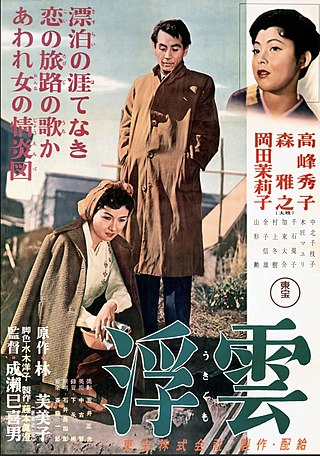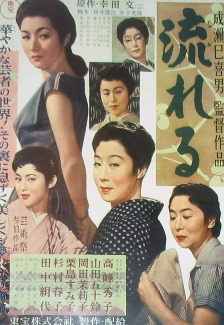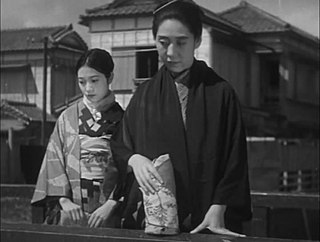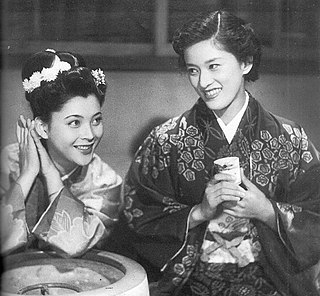Related Research Articles

Fumiko Hayashi was a Japanese writer of novels, short stories and poetry, who has repeatedly been included in the feminist literature canon. Among her best-known works are Diary of a Vagabond, Late Chrysanthemum and Floating Clouds.

Mikio Naruse was a Japanese filmmaker who directed 89 films spanning the period 1930 to 1967.
Repast is a 1951 Japanese drama and shōshimin-eiga film directed by Mikio Naruse and starring Setsuko Hara. It is based on the final and unfinished novel by Fumiko Hayashi, and was the first in a series of adaptations of her work by the director.

Haruko Sugimura was a Japanese stage and film actress, best known for her appearances in the films of Yasujirō Ozu and Mikio Naruse from the late 1940s to the early 1960s.

Floating Clouds is a 1955 Japanese drama film directed by Mikio Naruse. It is based on the novel Ukigumo by Japanese writer Fumiko Hayashi, published just before her death in 1951. The film received numerous national awards upon its release and remains one of director Naruse's most acclaimed works.

Flowing is a 1956 Japanese drama film directed by Mikio Naruse. It is based on the novel Nagareru by Aya Kōda.

Lightning is a 1952 Japanese drama film directed by Mikio Naruse. It is based on the 1936 novel by Fumiko Hayashi and was the second in a series of adaptations of Hayashi's work by Naruse after the 1951 Repast.

Mother is a 1952 Japanese drama film directed by Mikio Naruse starring Kinuyo Tanaka in the title role. The screenplay by Yūko Mizuki is based on the prize-winning entry of a school essay-writing competition.
A Wanderer's Notebook , also titled Her Lonely Lane, is a 1962 Japanese drama film directed by Mikio Naruse starring Hideko Takamine. It is based on the autobiographical book Diary of a Vagabond by Fumiko Hayashi and its stage adaptation by Kazuo Kikuta.

Older Brother, Younger Sister is a 1953 Japanese drama film directed by Mikio Naruse. The film is based on the short story Ani imōto by Saisei Murō.

Apart From You is a 1933 Japanese silent drama film written and directed by Mikio Naruse. The film follows an aging geisha whose teenage son is ashamed of her profession, and their relationship with a young colleague of hers.

Husband and Wife is a 1953 Japanese comedy-drama film directed by Mikio Naruse.

Wife! Be Like a Rose!, also titled Kimiko, is a 1935 Japanese comedy drama film directed by Mikio Naruse. It is based on the shinpa play Futari tsuma by Minoru Nakano and one of Naruse's earliest sound films. Wife! Be Like a Rose! was one of the first Japanese films to see a theatrical release in the United States.

Street Without End is a 1934 Japanese silent drama film directed by Mikio Naruse, based on a newspaper serial by Komatsu Kitamura. It was Naruse's last silent film and his final film for the Shochiku studio.

No Blood Relation is a 1932 Japanese silent drama film directed by Mikio Naruse, based on a novel by Shunyo Yanagawa. It is the first surviving feature-length film by the director.
As a Wife, As a Woman, also titled The Other Woman and Poignant Story is a 1961 Japanese drama film directed by Mikio Naruse.
Anzukko is a 1958 Japanese drama film directed by Mikio Naruse. It is based on a novel by Saisei Murō.
Bangiku, translated into English as A Late Chrysanthemum and Late Chrysanthemum, is a short story by Japanese writer Fumiko Hayashi, first published in 1948. It received the Women's Literary Award the same year and was later adapted into a film. The story describes an ageing ex-geisha who makes preparations to meet a former lover while reflecting on her past life.
The Song Lantern, also titled A Song by Lantern Light, is a 1943 Japanese drama film by Mikio Naruse. It is based on a novel by Kyōka Izumi.
A Brother and His Younger Sister, also titled An Older Brother and His Younger Sister, is a 1939 Japanese comedy-drama film written and directed by Yasujirō Shimazu. Together with Our Neighbor, Miss Yae (1934), it is regarded as one of Shimazu's major films, and a representative of the shōshimin-eiga genre.
References
- 1 2 "晩菊 (Late Chrysanthemums)" (in Japanese). Kinenote. Retrieved 8 July 2023.
- 1 2 Galbraith IV, Stuart (2008). The Toho Studios Story. Scarecrow Press. p. 102. ISBN 9780810860049.
- ↑ Goble, Alan, ed. (1999). The Complete Index to Literary Sources in Film. London, Melbourne, Munich, New Providence: Bowker-Saur. ISBN 978-1 8573-9229-6.
- ↑ Fujiki, Hideaki; Phillips, Alastair, eds. (2020). Japanese Cinema: Texts and Contexts. London and New York: The British Film Institute/Bloomsbury. ISBN 978-1-8445-7679-1.
- ↑ Mulhern, Chieko Irie, ed. (1994). Japanese Women Writers: A Bio-critical Sourcebook. Westport and London: Greenwood Publishing Group. ISBN 978-0-3132-5486-4.
- ↑ Mansfield, Stephen (1 August 2020). "'A Late Chrysanthemum': A short story collection full of pathos and maturity". The Japan Times. Retrieved 21 January 2021.
- ↑ Ericson, Joan E. (1997). Be a Woman: Hayashi Fumiko and Modern Japanese Women's Literature. Honolulu: University of Hawai'i Press. ISBN 9780824818845.
- ↑ "キネマ旬報ベスト・テン 1954年・第28回". Kinenote (in Japanese). Retrieved 8 July 2023.
- 1 2 Russell, Catherine (2008). The Cinema of Naruse Mikio: Women and Japanese Modernity . Durham and London: Duke University Press. ISBN 978-0-8223-4290-8.
- 1 2 3 Rosenbaum, Jonathan (23 February 2006). "Geishas Without Diaries". Chicago Reader. Retrieved 8 July 2023.
- 1 2 "Late Chrysanthemums (Bangiku)". BAMPFA. 22 December 2014. Retrieved 8 July 2023.
- ↑ Uhlich, Keith (1 March 2006). "Late Chrysanthemums – Film Review". Slant Magazine. Retrieved 25 January 2016.
- ↑ "1954 Blue Ribbon Awards" (in Japanese). Archived from the original on 7 February 2009. Retrieved 31 December 2020.
- ↑ "Mikio Naruse: A Master of the Japanese cinema – Opens at MoMA September 23" (PDF). Museum of Modern Art. Retrieved 8 July 2023.
- ↑ "Late Chrysanthemums". Harvard Film Archive. 7 October 2005. Retrieved 21 July 2023.